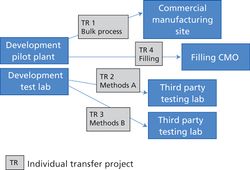Maximize Efficiency in Tooling Maintenance
A seven-step process may reduce many common tablet and tooling problems, resulting in a better quality end product.
Cleaning for tablet press tooling is essential within pharmaceutical manufacturing. It is vital to remove any contaminants from punches and dies to prevent cross-contamination during tablet compression. Cleaning should be the first step in a planned maintenance and audit program. Based on this understanding, ultrasonic cleaning has been developed to clean tablet tooling products efficiently and to a high standard.
Ultrasound transducers create microscopic bubbles that provide a soft, yet comprehensive cleaning action, eliminating the need for abrasive cleaning. Ultrasonic cleaning is therefore highly effective at cleaning the fine and delicate details of tablet compression tooling in and around embossing, for example.
Traditionally, tool cleaning is often carried out manually using brushes, and alcohol. This is a time consuming method, however, and is often ineffective at removing contaminants that have adhered to areas such as embossing on the tip face, keyways, and seal grooves, which make the contaminants difficult to reach and remove. With manual cleaning methods, effectiveness often varies from technician to technician depending on how skilled they are.
Precise cleaning
Using a precise and detailed cleaning method, such as ultrasonic cleaning, provides the most reliable method to remove any contaminants. Ultrasonic cleaning can deliver an extremely clean surface within a few minutes with a cleaning process that is repeatable, unlike the manual techniques identified previously.
During the ultrasonic cleaning process, a technician will load the punches and dies into a stainless-steel basket ready for cleaning, which is then submerged into an ultrasonic cleaning tank. Ultrasonic cleaning units contain a converting transducer that produces sonic frequencies approaching 40,000 cycles per second that create millions of microscopic vacuum bubbles. These then implode when they make contact with a surface and therefore remove all dirt and other contaminants including toxic chemicals.
Cleaning process
This cleaning is a result of the release of energy caused by the production and collapse-otherwise known as cavitation-of the microscopic vacuum bubbles. This energy release results in sound waves that reach, break up, and lift off all of the dirt, residue, and other contaminants, which are then removed from the machined face, before being carried away as a suspended particle.
Certain parts, typically tablet punches require a more thorough clean to avoid quickly clogging up with contamination. This application enables pharmaceutical manufacturers to extend the time between scheduled routine maintenance for machinery parts and as a result, improve productivity and lower labor costs.
Ideal conditions
There are preferred conditions to operate in when performing an ultrasonic clean on tablet compression tooling. “With the units we supply, we recommend cleaning tablet tooling for 10 minutes at 50 °C,” says Andy Dumelow, PharmaCare product and market manager at I Holland.
As steel is the primary component, “the units must contain a detergent designed for use in an ultrasonic cleaner and for cleaning steel components,” he goes on to say. “Also, because the majority of tablet tooling is not stainless steel, a corrosion inhibitor must be used.”
One part of the process
While cleaning is one of the most important parts of a tooling maintenance program, it only makes up part of the overall process. Cleaning should, therefore, form only the first step in maximizing efficiency and achieving optimum productivity within tableting equipment.
Once the cleaning process has been completed, the tooling should then undergo a thorough and comprehensive full maintenance process to ensure punches and dies are maintained and stored correctly.
PharmaCare seven-step process
Adopting a robust tooling maintenance process is essential to help eliminate a key number of tablet manufacturing problems and tablet tooling failures. I Holland’s PharmaCare 7 Step Process is a logical, planned, and professional approach to tooling maintenance, measuring, and storage that has been adopted by many companies as a standard operating procedure.
Step one: Clean. This is the most critical step (along with Step 5: Polish) as punch and die cleaning delivers noticeable benefits during production, reduces tablet press downtime, and helps to increase productivity. Cleaning is vital to remove problematic residue to avoid product contamination and potential production issues, such as sticking and picking, caused by old product adhering to the surface of the punch tip.
Step two: Assess. Punches and dies need to be visually and regularly inspected. Once the tooling equipment has been cleaned and dried, it should then be carefully assessed, using the same microscopic precision that ultrasonic cleaning provides. Tooling should, therefore, be inspected under magnification to observe and identify any defects that can create tableting issues and disrupt performance.
This habit identifies whether any tooling maintenance is required. Identifying damage off the tablet press, at this stage, is far less expensive and time-consuming. High magnification lenses and microscopes, providing precision and clear high-quality imagery, should be used to display any signs of damage, wear, or corrosion, and to validate the cleaning process.
Step three: Repair. If tooling has experienced light surface wear, corrosion, and minor damage, then this can be repaired and re-worked to a useable condition. It is imperative that this repair is carried out, because worn tips can result in poor quality tablets and inferior embossing definition, which can lead to picking and sticking. Equipment including a motorized chuck and double-ended polishing motors are used in conjunction with abrasive polishing accessories. Repair should not be carried out on any coated tooling, because this may remove the coating from the punch. The repair should be carried out by well-trained and experienced maintenance technicians to ensure that the tooling does not exceed tolerance limits.
Step four: Measure. Measuring is essential after repair to ensure that critical tooling dimensions have been maintained within an acceptable working tolerance. The equipment required for measuring can range from simple hand-held micrometers, vernier callipers, and height gauges to semi-automatic, computerized digital gauging systems.
Measuring should be carried out at regular intervals to check for natural wear during the compaction process. The essential measurement is the critical working length of the punch, as this controls tablet thickness, weight, and ultimately, dosage.
Following the previous steps in the process, the measurement of the critical working length ensures that the punches are within an acceptable tolerance range for good tablet weight and thickness control. It also means that this measurement or other data are not affected by outside influences, such as oil or compacted granule.
Step five: Polish. Automated polishing will maximize efficient and effective tablet production by helping to keep tooling in optimum condition. By following this process and correct maintenance, costly tablet press downtime and compression problems associated with capping, tablet weight, and thickness variation can also be reduced.
Automated polishing is essential to ensure punches are evenly polished to a consistent finish. Automated polishing ensures optimum and consistent tooling condition for maximum productivity, reduced sticking, and saved labor costs in terms of time spent on polishing.
The automated drag polishing system offers a more controlled and consistent process, which does not rely on on the skill and experience of the operator. This also allows for up to 85 punches to be polished in one 20-minute cycle, providing efficiency gains. Re-cleaning after polishing is not required provided that a food-grade polishing media and paste is used during this operation.
Step six: Lubricate. Lubrication is important to protect, preserve, and aid smooth tooling operation in the press. A range of oils and greases can be recommended for different applications such as preservatives or for lubrication purposes. A non-toxic, FDA-compliant oil or grease is recommended for this step.
In addition, a product that offers machine component protection and lubrication performance with a wide temperature range is sought to ensure it is appropriate for use in all machines.
Step seven: Store. Tooling storage and transportation should be purposefully designed and developed to maximize security and safe handling to minimize damage and deterioration. There are a variety of products available to store tablet tooling safely and securely including custom-built storage cabinets and storage containers.
It is imperative that the tooling itself is separated to avoid contact and to ensure that the tooling condition does not deteriorate during storage. Due to the nature and weight of tablet tooling, storage should also ensure safe handling for operators, and therefore, tools should only be handled when necessary.
Conclusion
The application of the seven-step process may have a direct impact on the reduction of many common tablet and tooling problems, resulting in a better quality end product, which can provide direct cost savings to the tablet manufacturer. The PharmaCare 7 Step Process, developed by I Holland, follows years of research and experience in tablet tooling manufacture. It has been designed to help users extract the maximum life from tablet tooling through a consistent approach to tooling maintenance that supports production.



